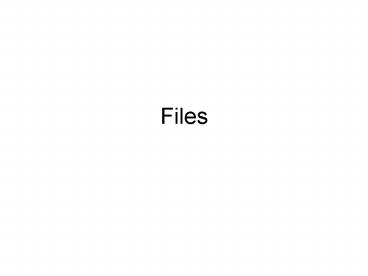Files - PowerPoint PPT Presentation
Title:
Files
Description:
Files System Calls for File System Accessing files Open, read, write, lseek, close Creating files Create, mknod System Calls for File System Manipulation & Navigation ... – PowerPoint PPT presentation
Number of Views:11
Avg rating:3.0/5.0
Title: Files
1
Files
2
System Calls for File System
- Accessing files
- Open, read, write, lseek, close
- Creating files
- Create, mknod
3
System Calls for File System
- Manipulation Navigation
- Chdir, chroot, chown, chmod, stat, fstat
- Special file and operations
- Pipes, dup
- Extending and changing the file system
- Mount, umount, link and unlink
4
Open
- Opens a file located on the file system by
returning an integer file descriptor (fd) - Other system calls then use the fd to carry out
operations on the opened file - Read, write, lseek, etc.
- Fd open(char, flags, mode)
5
Open
- Input to the open system call is
- Pathname char string
- Open flags integer value
- Mode integer value
- Kernel converts the char file name into an inode
6
Open
- Allocates an entry in file table
- File table entry has a pointer to the inode and
field that indicates the byte offset - Byte offset is typically set to Zero, the
beginning of the file, but can be set to the end
of the file.
7
Open Algorithm
8
Data Structures After Open
9
Data Structure After 2 Processes
10
Notes about Open System Call
- Each open system call
- Returns a single user file descriptor
- Points to a unique file table index
- Inode table entry can have multiple links
11
Reading and Writing
- Once a file is opened
- We can then operate on it via the file descriptor
(i.e. fd) - Open system call syntax
- open(fd, buffer, count)
- fd file descriptor
- buffer place to store read data
- count number of bytes to read
12
Read and U Area
- Sets I/O parameters namely
- Mode (Read or Write)
- Count field
- Target address for user data buffer
- Byte offset in file where I/O should begin
- Address Flag (User or Kernel)
13
Read Example
14
Writing
- Similar to read
- Except
- Allocate new data blocks
- Allocate new indirect blocks
- Updates inode for file.
- What does datum does it update in inode?
- Disk Block, indirect block, file size,
modification time, etc,
15
Write System Call
- Syntax of write system call
- write(fd, buffer, modes)
- fd is file descriptor
- buffer is memory where data to write is found
- Count is number of bytes to write
16
Writing Notes
- Data is written in at most one block size
- Write system call may have to read a block before
it writes - Inode for file is locked until write() is
completed - Allocation of new blocks
- Modifies inode
17
Pipes
- Allows the exchange of data between processes
- Data exchange is in a FIFO manner
- Can be used to synchronize process executions
18
Pipes
- Two classes of pipes
- Named pipes
- Use open
- Unnamed pipes
- Use pipe system call
- Use traditional































